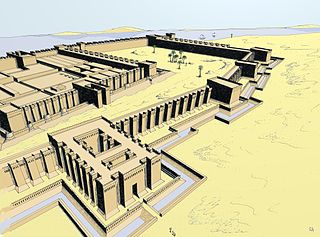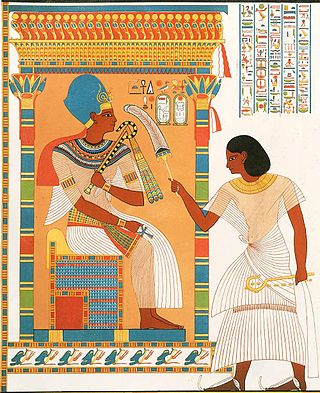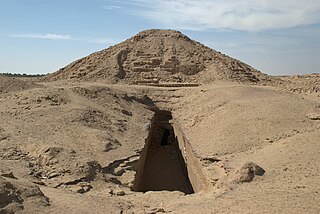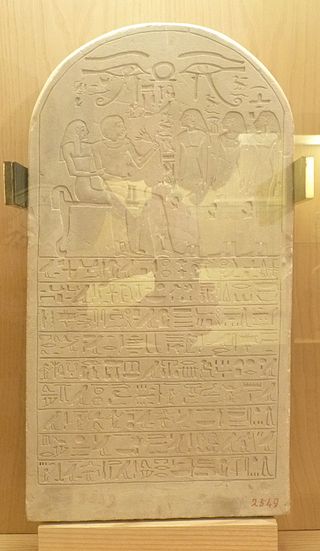Related Research Articles

Aspelta was a ruler of the kingdom of Kush. More is known about him and his reign than most of the rulers of Kush. He left several stelae carved with accounts of his reign.
The former Kingdom of Kerma in Nubia, was a province of ancient Egypt from the 16th century BCE to 11th century BCE. During this period, the region was ruled by a viceroy who reported directly to the Egyptian Pharaoh.

Buhen, alternatively known as Βοὥν (Bohón) in Ancient Greek, stands as a significant ancient Egyptian settlement on the western bank of the Nile, just below the Second Cataract in present-day Northern State, Sudan. Its origins trace back to the Old Kingdom period, where it served as an Egyptian colonial town, particularly recognized for copper smelting. In 1962, archaeological discoveries brought to light an ancient copper manufacturing facility encircled by an imposing stone barrier, indicating its origin during the rule of Sneferu in the 4th Dynasty. Inscriptions and graffiti disclosed a continuous Egyptian presence spanning two centuries, only to be interrupted by migration from the southern regions in the 5th Dynasty.

Atlanersa was a Kushite ruler of the Napatan kingdom of Nubia, reigning for about a decade in the mid-7th century BC. He was the successor of Tantamani, the last ruler of the 25th Dynasty of Egypt, and possibly a son of Taharqa or less likely of Tantamani, while his mother was a queen whose name is only partially preserved. Atlanersa's reign immediately followed the collapse of Nubian control over Egypt, which witnessed the Assyrian conquest of Egypt and then the beginning of the Late Period under Psamtik I. The same period also saw the progressive cultural integration of Egyptian beliefs by the Kushite civilization.
Ahmose called Turo was Viceroy of Kush under Amenhotep I and Thutmose I.

Merymose, also Mermose or Merimes, was a Viceroy of Kush under Amenhotep III. He served for almost the entire four decades of that reign.

Amenhotep called Huy was Viceroy of Kush under 18th Dynasty King Tutankhamen. He was the successor of Tuthmosis, who served under Akhenaten. He would later be succeeded by Paser I.

Amenemopet served as Viceroy of Kush during the reign of Seti I.
Heqanakht was Viceroy of Kush during the reign of Ramesses II. His titles include: King's son of Kush, overseer of the Southern Lands, Fan-bearer on the Right Side of the King, Messenger to every land, Hereditary prince, royal sealbearer.
in Ancient Egypt, Paser II was the son of the High Priest of Min and Isis named Minmose. Paser came from a very well-connected family. One uncle was the High Priest of Amun Wennenefer and another uncle was the troop commander of Kush named Pennesuttawy. Through Wennenefer, Paser was related to Amenemone, Amenemope and Hori, the High Priest of Anhur.
Paser I was the Viceroy of Kush during the reigns of Ay and likely Horemheb. Reisner mentions that the only datable inscriptions for Paser belong to the reign of Ay. The next known Viceroy however is Amenemopet, who is dated to the reign of Seti I. Hence it's possible that Paser I served during the reigns of Ay, Horemheb.
Tuthmose was the Viceroy of Kush during the reign of Akhenaten. Tuthmose was given the titles King's Son of Kush, Overseer of the Gold Lands of Amun, Overseer of masons, Overseer of the borderlands of His Majesty, and Fan-bearer on the King's right.
Hori I, son of Kama, was Viceroy of Kush under Siptah and is attested in year 6 of that king. He likely continued to serve under Twosret, Setnakhte, and Ramesses III. Hori's titles include: King's Son of Kush, First charioteer of His Majesty, and King's messenger to every land. Hori I was succeeded by his son who was also called Hori.

The Viceroy of Kush Seti is attested in year 1 of Siptah. Seti is also mentioned on some monuments of his son Amenemhab. Amenemhab was the son of Seti and the Lady Amenemtaiauw. Seti held the titles fan-bearer on the king's right, and king's scribe of the letters of the Pharaoh. His son Amenemheb served as Head Bowman, Charioteer of His Majesty, and Overseer of the Southern Lands.

Wentawat, was Viceroy of Kush under Ramesses IX, during the 20th Dynasty. He was a son of the Viceroy Nahihor.

El-Kurru was the first of the three royal cemeteries used by the Kushite royals of Napata, also referred to as Egypt's 25th Dynasty, and is home to some of the royal Nubian Pyramids. It is located between the 3rd and 4th cataracts of the Nile about 1 mile (1.6 km) west of the river in what is now Northern state, Sudan. El-Kurru was first excavated by George Reisner in 1918 and 1919 and after his death his assistant Dows Dunham took over his work and published the excavation report on El-Kurru in 1950. The El Kurru cemetery was primarily used from about 860 BC until 650 BC. The first tomb with a name attached to it is that of King Piye dating to about 750 BC, the sixteen earlier tombs possibly belong to Piye's royal predecessors. The last 25th dynasty king, Tantamani, was buried at El Kurru around 650 BC. The subsequent Napatan rulers chose to be buried at the royal cemetery at Nuri instead. However, in the mid-4th century the 20th king, whose name is unknown, chose to have his tomb, as well as that of his queen, built at El Kurru.

The Theban Tomb TT383 is located in Qurnet Murai, part of the Theban Necropolis, on the west bank of the Nile, opposite to Luxor. It is the burial place of the ancient Egyptian Viceroy of Kush named Merymose, who lived during the 18th Dynasty and served under Amenhotep III.
Iuty was an ancient Egyptian vizier presumably of the Late New Kingdom whose family tomb made up of bricks was discovered in December 1964 by the Egyptian archaeologist Shafik Farid, in the so-called "Cemetery of the Nobles" of Bubastis. The tomb was situated near to the family tombs of Hory I and Hory II, two viceroys of Kush during the 20th Dynasty. Iuty's tomb architecture has remained unpublished, but some objects of the burial equipment including faience and calcite shabtis as well as a calcite model scribe's palette have recently been studied. Iuty cannot be dated precisely at present; but according to the German Egyptologist Jan Moje, he may have officiated during the 20th Dynasty. A calcite canopic jar belonging to Iuty's son, the high-priest of Bastet, Ay, was also found in the same tomb. Before this discovery Iuty was only known from a few objects seen at the beginning of the 20th century on the art market in Cairo.

Hormeni was an ancient Egyptian dignitary who officiated at the beginning of the Eighteenth Dynasty.

Yuni served as Head of the-stable-of-Seti-I, Charioteer of His Majesty, and Chief of the Medjay before becoming Viceroy during the reign of Seti I. He would use some of these titles simultaneously. On a stela from Abydos – now in the Cairo Museum – the inscription reads:
Made by the Superintendent of Deserts in the Southern Foreign country, Viceroy in Nubia (Ta-Sety), Chief of Works in the Estate of Amun, Chief of the Madjayu-militia, Iuny. (Kitchen)
References
- ↑ The Viceroys of Ethiopia (II) by George A. Reisner The Journal of Egyptian Archaeology, Vol. 6, No. 1. (Jan., 1920)
- ↑ The Viceroys of Ethiopia (II) by George A. Reisner The Journal of Egyptian Archaeology, Vol. 6, No. 1. (Jan., 1920)
- ↑ Editorial Foreword The Journal of Egyptian Archaeology © 1963
- ↑ A. Dodson and S. Ikram, The Tomb in Ancient Egypt: Royal and Private Sepulchres from the Early Dynastic Period to the Romans, 2008, p. 268, Thames & Hudson.